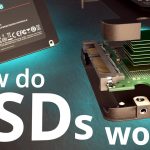You may have seen a lot of talk about Solid State Drives recently. In the last six months or so they‟ve really taken the mid-range to high end computing world by storm. If a manufacturer decides to include a solid state drive in their computer they‟ll make sure that you know it‟s there. But what are they?

A solid-state drive (or SSD) is a storage device that performs the same functions as a hard disk drive (which you may know as a hard drive or an HDD). This means that it‟s used to store data for your computer to access, including the computer‟s operating system, its programs and all your files such as documents, pictures, music and videos. The larger the drive, the more you can store on it. It gets its name from the fact that it has no moving parts, hence making it „solid state‟.
However, while they fulfil the same role, SSDs and HDDs have some crucial differences, which I‟ll explain later.
A Quick History of SSDs
Solid State Drives in the literal sense have been around since the 1950s, although it wasn‟t until 1983 that the first “modern” solid state drive was readily available: Sharp‟s PC-5000 laptop‟s internal storage held a whopping 128 kilobytes of data and used magnetism in a similar way to today‟s magnetic hard drives.1GB of flash memory would have cost $1 million. Crazy, huh?
In 1986 a company called Santa Clara Systems introduced “BatRam”, which used 4MB modules that acted in a similar way to today‟s Random Access Memory (RAM) and required batteries to retain the data if the system lost power.
It wasn‟t until 1995 that flash-based solid-state drives were released, which work the same way that today‟s solid-state drives do and which don‟t require a constant supply of power to hold on to their data. At this point solid-state technology was embraced by the aerospace and military industries. It would take almost 15 years before the technology became commercially viable for use in mainstream computers.
Flash made its debut in the public eye in the form of memory cards for digital cameras, such as the Compact Flash (CF) card in 1996, where 2MB of storage would cost you $149 (or $74,500/GB).
The USB Flash Drive (or Memory Stick) first showed up in late 2000, when IBM released its 8MB “DiskOnKey” for $49 ($6,125/GB). This was still comparatively extremely expensive, but makes quite a bit of sense when put into context; the alternative was the 3.5” floppy disk that held 1.44MB of data. The IBM DiskOnKey held more than 5 times as much data in one place and was not susceptible to scratches, magnetism or dust. It was significantly faster, too!
USB Flash storage understandably caught on in a big way and by 2003 was widely available in 32, 64 and 128MB capacities from a myriad of manufacturers. A 64MB flash drive would usually cost around $70 ($1095/GB), and it only got cheaper from there. Today you can get a 4GB drive for $3 ($0.75/GB), the average size drive is 16GB for $15 ($0.93/GB), and they are available in sizes up to 256GB for $100 ($0.40/GB).
Flash storage made its first massive appearance for internal storage in consumer electronics in 2005, but not in computers. The iPod Shuffle and the iPod Nano were among the first devices to bring flash memory to millions. They were by no means the first to use the technology; Rio released its PMP300 way back in 1998, which got you 32MB of storage for $200. However, Apple‟s wild success with the iPod and then the iPod Nano transferred instantly to the Shuffle and Nano, which started with 512MB or 1GB and 2GB or 4GB of storage, respectively.
In 2007 Alienware, a company that specialises in making gaming laptops and desktops, introduced a 32GB SSD as an option for custom machines. This 32GB drive cost a steep $500 ($15/GB), especially painful as it meant sacrificing a much roomier hard drive for the privilege.
In 2008 Apple unveiled the MacBook Air for the first time. This thin laptop offered an optional 64GB SSD or an 80GB 1.8” conventional hard drive. This was the first mainstream 1.8” SSD; again, users had to pay a pretty penny for it. How much exactly? $1300 (or a whopping $20/GB)! While it‟s worth noting that 1.8” drives cost significantly more to manufacture, that doesn‟t really change quite how inaccessible the option was to most consumers.
In late 2010 Apple updated the MacBook Air to a new model, and made a big push for SSDs. The latest models have no option for magnetic hard drives at all, and shifted from the standard “SSD in a hard drive enclosure” to a new form factor that they dubbed as a “Blade SSD” which connected straight to the motherboard using the mini-PCIe interface.


